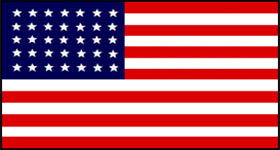Civil War Battles |
Colonial Wars |
American Wars |
Link To This Page — Contact Us —
The Battle of Wauhatchie/Brown's Ferry
October 28-29, 1863 in Hamilton-Marion-Dade Counties, Tennessee
Chattanooga Campaign
Union Forces Commanded by:
Maj. Gen. Joseph Hooker
Confederate Forces Commanded by: Brig. Gen. Micah Jenkins
**Missing and Captured Conclusion: Union Victory |
 |
BATTLE SUMMARY
http://www.rootsweb.com/~mnwabcw/32.htm
In an effort to relieve Union forces besieged in Chattanooga, Maj. Gen. George H. Thomas and Maj. Gen. Ulysses S. Grant initiated the "Cracker Line Operation" on October 26. This operation required the opening of the road to Chattanooga from Brown's Ferry on the Tennessee River with a simultaneous advance up Lookout Valley, securing the Kelley's Ferry Road. Union Chief Engineer, Military Division of the Mississippi, Brig. Gen. William F. "Baldy" Smith, with Brig. Gen. John B. Turchin's and Brig. Gen. William B. Hazen's 1st and 2nd brigades, 3rd Division, IV Army Corps, was assigned the task of establishing the Brown's Ferry bridgehead. Meanwhile, Maj. Gen. Joseph Hooker, with three divisions, marched from Bridgeport through Lookout Valley towards Brown's Ferry from the south. At 3:00 A.M., on the 27th, portions of Hazen's brigade embarked upon pontoons and floated around Moccasin Bend to Brown's Ferry. Turchin's brigade took a position on Moccasin Bend across from Brown's Ferry.Upon landing, Hazen secured the bridgehead and then positioned a pontoon bridge across the river, allowing Turchin to cross and take position on his right. Hooker, while his force passed through Lookout Valley on the 28th, detached Brig. Gen. John W. Geary's division at Wauhatchie Station, a stop on the Nashville & Chattanooga Railroad, to protect the line of communications to the south as well as the road west to Kelley's Ferry.
Observing the Union movements on the 27th and 28th, Lt. Gen. James Longstreet and Gen. Braxton Bragg decided to mount a night attack on Wauhatchie Station. Although the attack was scheduled for 10:00 pm on the night of the 28th, confusion delayed it till midnight. Shortly after midnight on the 29th, Gen. Micah Jenkins's brigade of South Carolinians launched a rare night attack on Gen. John W. Geary's Union corps at Wauhatchie, Tennessee. The Union line, in the shape of a V with sides facing to the east and the north, was fiercely attacked on both fronts by screaming Confederates rushing out of the darkness. Though the sudden attack pushed the Union soldiers backward until the 2 fronts were almost back to back, Geary's stalwart men managed to fight off Jenkins's attackers and hold their positions.
Three miles away at Brown's Ferry, Gen. Joseph Hooker, commander of the XI and XII Union Corps, heard the sounds of battle at Wauhatchie and dispatched two divisions to Geary's assistance. Marching toward the boom of the guns, the lead division, commanded by Gen. Carl Schurz, took the wrong road and got mired in the swamp. Geary's men continued to hold fast. Schurz's troops eventually extricated themselves and marched on toward Wauhatchie, only to run into the Confederate brigade of Gen. Evander M. Law, which was positioned on a small hill that dominated the road from Brown's Ferry.
Law's men were greatly outnumbered and almost encircled by Schurz's division, but the hilltop position was naturally strong, and several vigorous Union assaults were repulsed with great slaughter. Then Gen. Adolph von Steinwehr's division reinforced Schurz's men, and together they drove the Confederates off the hill with a furious bayonet charge.
As the Union reinforcements began arriving at Wauhatchie, Jenkins realized that the attempt to capture Wauhatchie was failing and ordered his troops to withdraw. A rumor circulated through the Union camps that Union mules that were stampeded by the fight had made the Confederates believe they were being attacked by cavalry, causing the Confederate retreat.
The Federals now had their window to the outside and could receive supplies, weapons, ammunition, and reinforcements via the Cracker Line. Relatively few night engagements occurred during the Civil War; Wauhatchie is one of the most significant.
